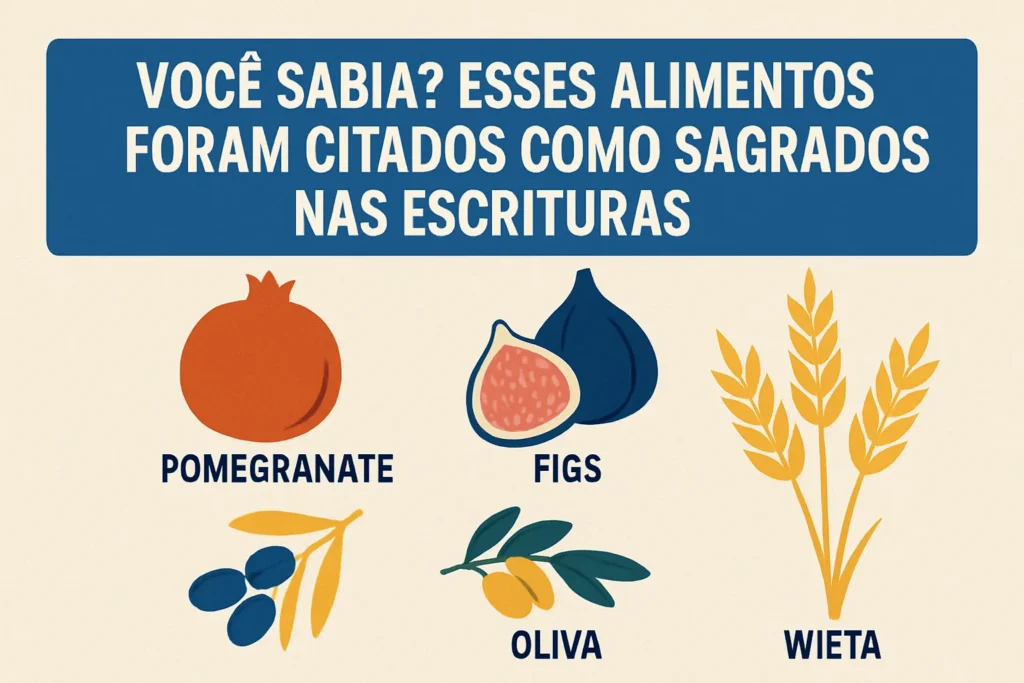Throughout history, food has always had a symbolic and spiritual role. And in the holy scriptures - such as the Bible, the Torah and the Koran - certain foods are mentioned not only as physical sustenance, but also as part of the relationship between human beings and the divine.
Many of these foods are considered sacred to this day, either because of their spiritual significance, their use in rituals or simply because they are mentioned in important moments of faith. In this post, you'll learn about what these foods are, what they represent and where they are mentioned in the scriptures.
Get ready to rediscover bread, wine, honey and even pomegranates with a deeper look.

1# Bread - symbol of divine provision
Bread certainly is, one of the most sacred foods in the scriptures. It appears several times in the Bible as a symbol of God's provision for his people. In the Old Testament, the "manna" sent from heaven was a divine way of feeding the Israelites in the desert.
In the New Testament, bread gains even more prominence with the figure of Jesus:
"I am the bread of life. He who comes to me will never hunger." - John 6:35
At the Holy Supper, Jesus breaks bread and offers it to his disciples as a representation of his body, creating one of the most profound rituals of the Christian faith.
More than just food, bread represents sustenance, communion and faith.
2# Wine - a symbol of alliance and celebration
Wine is also strongly present in the scriptures. In the Old Testament, it is associated with joy and abundance. In the New Testament, Jesus turns water into wine in the first miracle, during the wedding at Cana, symbolizing new beginnings and celebrations.
At the Supper, the wine represents the blood of Christ, seal of a new covenant between God and humanity.
"This cup is the new covenant in my blood." - Luke 22:20
For Jews, wine also has a strong presence in rituals such as Shabbat, and represents joy and sanctification.
3# Honey - sweetness of the Word and the promise
Honey is mentioned several times in the Bible as a gift from nature and a metaphor for what it is pleasant, pure and precious.
The famous description of the Promised Land as "a land flowing with milk and honey" (Exodus 3:17) represents abundance, fertility and divine blessings.
"How sweet are your words to my taste, sweeter than honey to my mouth!" - Psalm 119:103
In Islamic tradition, honey is also mentioned as healing foodin both body and soul, as appears in Surah 16 (An-Nahl).
4# Olive oil - symbol of anointing, healing and light
Olive oil goes far beyond cooking: it was used for anointing kings and prophetsThe temple is also used for healing wounds and feeding lamps.
It is a symbol of anointing, consecration, healing and enlightenment. In the Psalms, David writes:
"You anoint my head with oil, my cup runneth over." - Psalm 23:5
In Hebrew culture, pure olive oil was essential for the functioning of the temple. And even today, in many religions, oil is used in blessings, baptisms and healing prayers.
5# Pomegranate - beauty, fertility and justice
The pomegranate appears in several biblical passages, both symbolically and literally. It was used to decorate the priests' garments (Exodus 28:33) and in details of the temple built by Solomon.
Because it contains many seeds, it has come to symbolize fertility, multiplication and prosperity. Some scholars say that the 613 seeds of the pomegranate represent the 613 commandments of the Torah.
It is also considered a symbol of justice and spiritual blessings.
6# Figo - the fruit of reflection and responsibility
The fig features prominently in symbolic passages. In the book of Genesis, after eating the forbidden fruit, Adam and Eve use fig leaves to cover their nakedness, showing awareness.
Later on, Jesus curses a fruitless fig tree as a spiritual warning sign:
"Let no more fruit come from you." - Matthew 21:19
In Jewish tradition, the fig also represents the importance of bearing spiritual fruit and living with purpose.
7# Wheat and barley - work, harvest and faith
Wheat and barley were the staple of the diet in biblical times and are directly linked to the the idea of sowing, harvesting and provision.
Jesus uses the grain of wheat as a metaphor for death and resurrection:
"Except a corn of wheat fall into the ground and die, it abideth alone: but if it die, it bringeth forth much fruit." - John 12:24
Barley was the most common grain among the poor and also symbolizes humility and simple but sacred sustenance.
8# Pisces - spiritual provision and mission
Fish appear frequently in the Gospels. Jesus multiplies the loaves and fishes to feed the crowds and calls ordinary fishermen to be "fishers of men."
"Follow me, and I will make you fishers of men." - Matthew 4:19
In Christian culture, the fish has become a symbol of faith, of the evangelizing mission and of sharing.
Why are these foods considered sacred?
Because they carry meanings that go beyond the dish. They represent:
- The relationship between heaven and earth
- God's provision in difficult times
- Gratitude and communion with others
- The sacred that exists in the simple
- Faith lived out in a concrete way
Even today, many of these foods are still present in rites, prayers, feasts and important moments of faith.
See also: Prayer to calm the anguished heart and bring peace
April 22nd, 2025
With much faith and positivity, she writes for the Oração e Fé daily, bringing messages and Divine teachings to everyone.